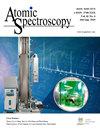Integration Of Hydrogen Evolution Reaction And Microplasma Induced Vapor Generation: A Strategy For Improving Safety And Sensitivity Of Microplasma Optical Emission Spectrometry
IF 2.3
2区 化学
Q1 SPECTROSCOPY
引用次数: 0
Abstract
: Microplasma-induced vapor generation (μPIVG), particularly using only hydrogen, has attracted increasing attention in the field of atomic spectrometry. However, its application for field analysis of environmental samples remains limited owing to the difficulty of hydrogen storage and transportation. Herein, a non-noble metal electrode-based hydrogen evolution reaction (HER) was utilized as a safe and environment-friendly hydrogen supply method for the efficient μPIVG of Hg, Cd and Zn. Subsequently, HER-μPIVG was used for the sensitive field detection of Hg, Cd and Zn in environmental samples via miniature point discharge optical emission spectrometry (μPD-OES). In contrast to conventional hydrogen-enhanced μPIVG, hydrogen was produced in situ and in real time using a superior cathode composed of cobalt-phosphorous nanomaterial, eliminating the storage and transport of hydrogen requirements and improving the safety, sensitivity, and feasibility of μPIVG-μPD-OES. Under the optimized conditions, the limits of detection (LODs) were 0.8, 10, and 14 μg L −1 for Hg, Cd, and Zn, respectively, with relative standard deviations (RSDs) of < 4.7%. The accuracy and practicability of the proposed method were validated through Hg, Cd, and Zn determinations in two certified reference materials (CRMs) and several water samples with satisfactory results.析氢反应与微等离子体诱导蒸汽生成的集成:提高微等离子体光学发射光谱安全性和灵敏度的策略
微等离子体诱导蒸汽产生(μPIVG),特别是仅使用氢的微等离子体诱导蒸汽产生,在原子光谱领域引起了越来越多的关注。然而,由于氢气的储存和运输困难,其在环境样品现场分析中的应用仍然受到限制。本文采用基于非贵金属电极的析氢反应(HER)作为一种安全、环保的供氢方法,实现了Hg、Cd和Zn的高效μPIVG。随后,利用HER-μPIVG微点放电光谱法(μPD-OES)对环境样品中的Hg、Cd和Zn进行敏感场检测。与传统的氢增强μPIVG相比,μPIVG-μPD-OES采用由钴磷纳米材料组成的优越阴极原位实时制氢,消除了氢的储存和运输需求,提高了μPIVG-μPD-OES的安全性、灵敏度和可行性。在优化条件下,Hg、Cd和Zn的检出限分别为0.8、10和14 μ L−1,相对标准偏差(rsd) < 4.7%。通过两种标准物质(CRMs)和几种水样中汞、镉、锌的测定,验证了该方法的准确性和实用性。
本文章由计算机程序翻译,如有差异,请以英文原文为准。
求助全文
约1分钟内获得全文
求助全文
来源期刊

Atomic Spectroscopy
物理-光谱学
CiteScore
5.30
自引率
14.70%
发文量
42
审稿时长
4.5 months
期刊介绍:
The ATOMIC SPECTROSCOPY is a peer-reviewed international journal started in 1962 by Dr. Walter Slavin and now is published by Atomic Spectroscopy Press Limited (ASPL). It is intended for the rapid publication of both original articles and review articles in the fields of AAS, AFS, ICP-OES, ICP-MS, GD-MS, TIMS, SIMS, AMS, LIBS, XRF and related techniques. Manuscripts dealing with (i) instrumentation & fundamentals, (ii) methodology development & applications, and (iii) standard reference materials (SRMs) development can be submitted for publication.
 求助内容:
求助内容: 应助结果提醒方式:
应助结果提醒方式:


